Life Alert is widely recognized as the second-largest medical alert systems company in the U.S. behind Philip’s Lifeline. After finding their roots in 1987, they have since spread across the country, with offices in New Jersey, New York, California, and Florida with a total of 8 offices. Their headquarters is located in Encino, CA, in the greater Los Angeles area.
According to its website, the company’s call center handles over two million calls a year and employs a staff of 600. Life Alert’s various products are focused on helping the elderly, and other users live independently at home with a sense of peace and security.
How It Works:
The Life Alert system allows users to connect with their trained emergency response center dispatcher for help through pressing a help button that is worn as a wristband, pendant, or a necklace. The help button is wirelessly connected to a base console unit, which lets seniors access their service anytime, 24 hours a day, seven days a week.
Besides their standard in-home system for health and fall emergencies, the company also offers additional options like an on-the-go button with GPS, a mobile 911 phone, and alert services activated through a cell phone. But unfortunately, they do not provide any automatic fall detection systems.
The average response of Life Alert was 69.58 seconds. Generally, you can expect an operator to start talking to you in a little over a minute. This may be a bit too long, as every second counts in an emergency. Once help arrives, it is their priority to reach the user through any means possible — this may mean breaking down your door or windows to get to the person in need quickly.
If you require assistance and you’re worried that your door is broken down or any other part of your home is damaged when they try to reach you, here is a suggestion that you can implement to let Life Alert know a more natural way to get inside your home.
A lockbox is a simple container with a combination lock, and getting one can save you from any damages. With a lockbox, you can put your house keys in the box and leave the lockbox somewhere near your front door. In this way, emergency responders don’t have to break down your door or break windows to get to you.
Lockboxes are definitely worth it, and some services even offer free lockboxes; some sell them for as much as $30. Others might give you the option to rent one for $2 to $3 a month. Of course, the best option would be to get a lockbox as a one-time purchase, unless you can get one for free.
Preparing alternative ways to access your house makes it easier for paramedics to access your elderly family members, and helps to bring peace of mind as well as independence to our loved ones. Even if they live on their own, they will be comforted knowing that help can get to them promptly and that their door or windows won’t have to be broken down to get to them.
